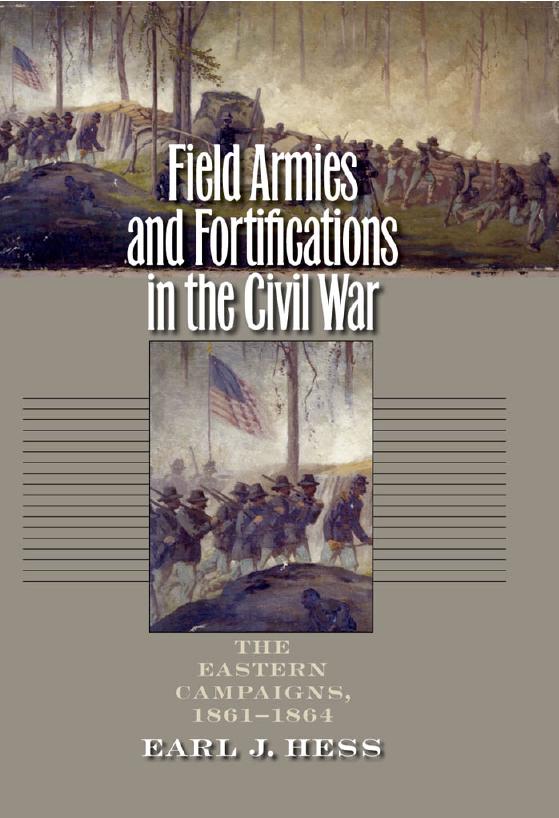
Field Armies and Fortifications in the Civil War: The Eastern Campaigns, 1861-1864
To order, go to: https://uncpress.org/book/9781469609935/field-armies-and-fortifications-in-the-civil-war/

"…a brilliant new study by veteran historian Earl Hess...Field Armies and Fortifications in the Civil War is one of the field’s best new books. It bridges the gap between studies of engineering and monographs about military operations, and will be sure to provide sophisticated readers with new insights available nowhere else. Hess projects two more volumes on this topic: one on the Overland campaign and one on the actions around Petersburg. I hope he is working on them this very minute—I can’t wait to read them." -- A. Wilson Greene, author of Breaking the Backbone of the Rebellion: The Final Battles of the Petersburg Campaign
"Earl Hess’ new scholarly study of field fortifications is a significant and welcome addition to our understanding of this important military facet of the Civil War. This valuable study deserves to be read and digested by military students at all levels and will likely prove to be an important reference work for some time to come." -- Andrew J. Wagenhoffer in North and South
We were perfectly protected by our breastworks, if it had not have been for them we would have been slaughtered by numbers. -- Lewis Warlick, 1st North Carolina, after the battle of Big Bethel
We at once went to work like beavers and when the sun rose we were behind works that could not be taken. -- Samuel D. Buck, 13th Virginia, at Mine Run
It was a splendid sight,...stretched a mile in length & one line behind the other, bayonets glistening in the sun, waiting anxiously for the word-’Forward, double quick.’ But still, beneath those blue jackets was many a fluttering heart, and although every man would obey orders, still when they looked on those lines of rifle pits and breastworks as far as the eye could reach, which it seemed impossible to take, their cheeks blanched, I know I felt my heart beat as audibly as the ticking of a clock, and the color came and went on my cheek. I looked on the sun[,] on the beautiful land around me as I thought for the last time. -- Charles A. Upson, 14th Connecticut, at Mine Run
During the first three years of the Civil War, both sides developed a keen realization that it was better to live behind a parapet, enduring the dirt, mud, baking sun, and bitter cold, than to die in combat in the open field. Civil War soldiers became experts in the building of field fortifications and earthworks came to play a vital role in determining the outcome of the conflict. The Civil War ended in the trenches around Petersburg, where Lee’s Army of Northern Virginia was pinned to the earth in the most sophisticated system of field fortifications yet seen in the history of the world.
This book explains why fortifications are an important component of understanding how the Civil War was fought. The focus of this study is on the campaigns of the major field armies, North and South, and how the soldiers and their commanders used (or failed to use) field entrenchments. It illuminates how far and why fortifications played a role in the success or failure of the armies, incorporating the engineering perspective into the operational perspective.
This book is based on a massive research project that included visits to more than 300 battlefields and fortification sites of the Civil War. Remnants of earthworks or masonry forts exist at 213 of them. Visits to non-Civil War military sites in the United States and overseas helped to set the conflict in perspective.
What did the soldiers and their commanders think about the use of fortifications? How did fighting behind earthworks affect their morale? How were field fortifications constructed? How were they designed to conform to the landscape? How and why did the reliance on earthworks evolve? What role did fortifications play in altering the tactical outcome of a battle and the strategic course of a campaign?
These questions are answered in this and succeeding volumes of what will be a multi-volume study of field fortifications in the Civil War. Field Armies and Fortifications covers the Eastern campaigns from 1861 through April, 1864, when fieldworks were widely but sporadically used in many major battles and campaigns such as on the Peninsula, at Chancellorsville, and at Mine Run. They also were widely constructed after First Bull Run, Fredericksburg, and Gettysburg. With the Wilderness and Spotsylvania, field fortifications loomed as one of the most important factors influencing the course of the campaigns in Virginia.
Two subsequent volumes detail the use of fortifications in the Overland Campaign and at Petersburg.
Published By:
The University of North Carolina Press
P.O. Box 2288
Chapel Hill, NC 27515-2288
1-800-848-6224
Full List of Books by Dr. Earl J. Hess